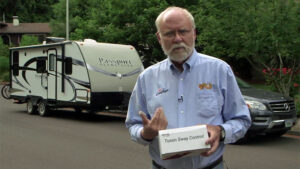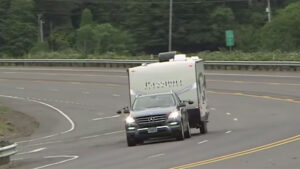Tuson Sway Control System for your RV
Towing a travel trailer is great fun. There’s all kinds of adventures out there awaiting you. But travel trailer sway, the lateral movement that’s unexpected, is something that can plague people a little bit now and then. Even a trailer and tow vehicle combination where they’re perfectly matched for weight, the trailer’s not too big, the tow vehicle isn’t too small, you have a weight distributing hitch that’s properly adjusted, trailer has the right front-to-back balance, all these characteristics; if they’re all correct and in line, you can still have a little bit of trailer sway, lateral movement, at unexpected times. For example, when you catch a strong gust of side wind, for example, or when a commercial truck passes you and you get caught in the bow wave and it’ll blow you around a little bit. Most of the time, of course, the driver can handle this and you correct for it and you’re just fine. So sway is not really a significant problem as far as most towing is concerned. But there are times when something happens and you get a little more sway, and sometimes it can be a pretty serious situation.
 Tuson Company has a new device called the Tuson Sway Control. This is a fairly new product. It’s a solid state electronic device, mounts on the trailer, and once it’s installed, there’s no driver input. You don’t have to do anything to it.It just is automatically there ’cause it’s powered by your– or it’s controlled by your brake control and by the internal components of the device, which we’ll talk about a little bit more.
Tuson Company has a new device called the Tuson Sway Control. This is a fairly new product. It’s a solid state electronic device, mounts on the trailer, and once it’s installed, there’s no driver input. You don’t have to do anything to it.It just is automatically there ’cause it’s powered by your– or it’s controlled by your brake control and by the internal components of the device, which we’ll talk about a little bit more.
Well, we’ve installed one of the Tuson Sway Controls on this little trailer and got the little Mercedes tow vehicle. We’re about to head over toward the Oregon coast. We’ve got a couple of drivers who’ve had a lot of experience
with this vehicle in stock trim. Now that it has a Tuson, we’ll head down the road, we’ll cover everything from two-lane roads up to four lanes, and we’ll see what happens and we’ll find out their experiences and get their opinions on it. The sooner we’re rolling down the road, the sooner we can tell you how it works.
The Tuson Sway Control mounts to the trailer chassis between 5 and 10 feet back from the hitch ball. The way the sway control functions requires the. installer to divide the trailer brakes into separate right-side and left-side systems. Due to the wiring complexity and modifying the trailer brake wiring, the Tuson manufacturer recommends the unit be installed. by a qualified service center. A solid state gyroscope is at the heart of the sway control. It senses lateral movement by the trailer. When the trailer starts to move side to side in a sway situation, the sway control selectively applies the brakes on one side or the other to pull the trailer back into line. There’s no driver input required. The driver only senses it’s working when the trailer quickly returns to a stable, straight-ahead towing position. A prewired LED indicator light provides function and troubleshooting codes.
Leslie Pranger: I just love to drive. I have to start out. saying that. I’ve always loved to drive. Put me in a car on a road and I’m a happy girl. I am feeling a difference. Again, I’m not sure– quite sure how to quantify that. I am not an engineer; my husband is, but I’m not, and I feel some kind of a difference, some kind of a tighter–it just feels tighter. It’s a long ride to the coast and you wanna feel– you wanna feel safe and comfortable as you’re going up and down and around corners, as I am right now, and it feels pretty darn good. And when I have to make steering changes quickly or even just around the tighter curve, again, it feels as if we are one unit with my vehicle and towing the trailer. I’m pretty pleased at this point.
Mike Pranger: Well, we’ve been driving this car and rig for about four years now, four summers’ worth. This Mercedes diesel does a fine job of towing it. It’s got a 6600 capacity and since the trailer is fully loaded, probably only about 5,000 pounds, tows it really nice. All right, so I’m an engineering manager with Daimler, and we make heavy duty trucks, and we happen to actually install these type of yaw sensors on our vehicles to help us with roll stability situations, to help make sure that tractors and trailers don’t tip over as easily going around corners. So I really understand the principle
of how the yaw sensor’s doing its job and the criticality to make sure it’s positioned on that trailer in the right location. And as I’m sitting here going down the highway at 60 miles an hour and I’m just doing some side-to side motions here, just checking to see what kind of fishtailing I’m getting, I’m noticing not very much. When I make a slight drive toward the center lane and over to the right edge, the trailer’s doing a very good job of tracking right behind me.I make a little bit sharper motion, looking for some fishtailing, and I see the trailer move, but really, not as much as I would have seen before we installed the unit.I feel it’s probably doing its job pretty well.
I’ve been making some of these moves from one side of the lane to the other fairly quickly and the trailer seems to be tracking pretty well. Kind of like this Tuson system. I think it’s really gonna help make sure that when I have to make some of those maneuvers, the trailer’s not gonna come around on me, and fall back in line the way it’s supposed to.
 Jeff: This combination with this little Mercedes tow vehicle, which seems kind of small, but the fact is it’s perfectly in control of that trailer. So it starts out as a good tow rig, but when you’ve got the addition of the Tuson Sway Control device, that gives you that extra little edge. It’s pretty incredible how you’ll be driving, you’re towing, you feel a little bit of push-pull back there, but otherwise, the trailer stays right behind the truck like it’s supposed to. I think it’s a– seems like a terrific device for anyone that wants to add that extra edge of safety and comfort and pleasure in towing.
Jeff: This combination with this little Mercedes tow vehicle, which seems kind of small, but the fact is it’s perfectly in control of that trailer. So it starts out as a good tow rig, but when you’ve got the addition of the Tuson Sway Control device, that gives you that extra little edge. It’s pretty incredible how you’ll be driving, you’re towing, you feel a little bit of push-pull back there, but otherwise, the trailer stays right behind the truck like it’s supposed to. I think it’s a– seems like a terrific device for anyone that wants to add that extra edge of safety and comfort and pleasure in towing.



